Akono and Company Teach UHS Students About Civil Engineering and Strength of Materials During I-STEM’s Multidisciplinary Summer Camp
October 2, 2017
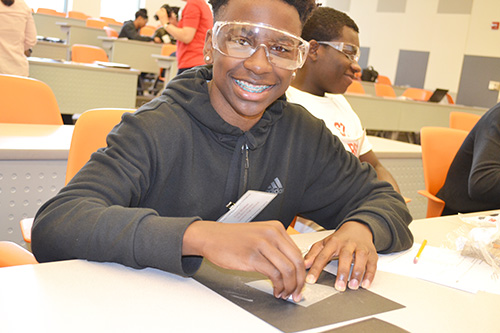
During CEE Day, a UHS student sands a specimen to be used in an indentaton test.
Concerned about bridges or other structures cracking? Civil & Environmental Engineering (CEE) Assistant Professor Ange-Therese Akono is. So on Wednesday, August 9, during I-STEM’s multi-disciplinary summer camp, she introduced 27 Urbana High School (UHS) students to her niche: determining the strength of various materials in order to build stronger structures. Plus, along with several hands-on activities related to Akono's Design for Toughness research philosophy, the students not only discovered what research is like, but got to interact with college students and to experience being on a college campus.
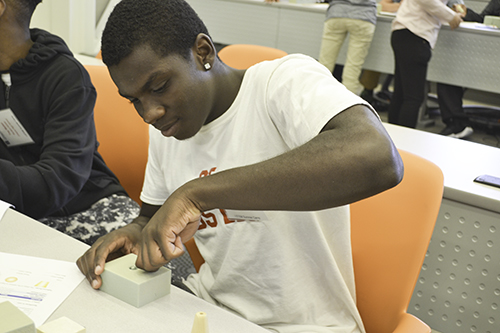
A UHS student tests the strength of a foam block during the indentation activity.
During the CEE Day activities, Akono and her students introduced the high-schoolers to jargon they use every day— concepts like the mechanics and physics of fracture and the connection between a material’s microstructure, composition, and fracture resistance. After each brief teaching, students performed a related hands-on activity. For instance, they did an indentation test to measure the strength of various materials, using metal balls to make indentations in a foam block, a limestone slab, and a piece of composite or plastic, then measuring the indentations in each.
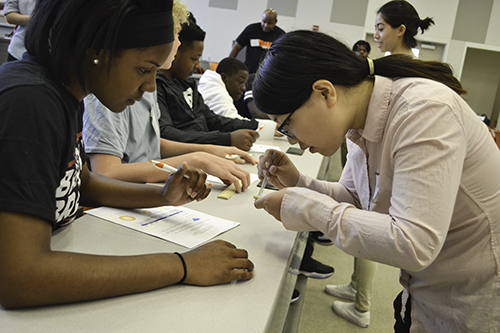
One of Akono's grad students (right) shows UHS student Lauryn Cross how to measure an indentation during a CEE Day hands-on activity.
To experience how researchers prepare stones for indentation tests, the high schoolers learned how to polish specimens. Using a four-part polishing process, they polished for two minutes using a very rough piece of sandpaper, repeating the step with progressively finer and finer sand paper, until the stones' surfaces were no longer cloudy and rough but so smooth and polished that an image of the building visible in the windows behind them was reflected on the face stone.
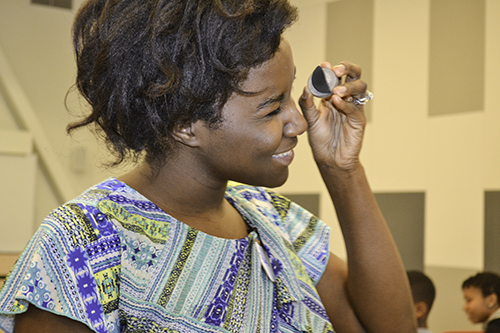
Akono looks at a specimen to see if it's been polished enough to perform an indentation test.
This procedure wasn’t busy work that Akono and company came up with to keep the students occupied; it’s what Akono’s students do in the lab every day in order to test materials. In fact, undergrad Anleng Cao insists, “I've done all the stuff that they're doing, so it's real lab work that they're doing. They're using real materials that were extracted from New York; they use big machines to get these rocks out. And they're using the real polishing heads that I also use in the labs. So, this is all exactly the same stuff. So that's pretty cool.”
The high schoolers also learned some principles about building sturdy structures, then were challenged to see which group could build the sturdiest popsicle-stick bridge, which they tested at the end of the day.
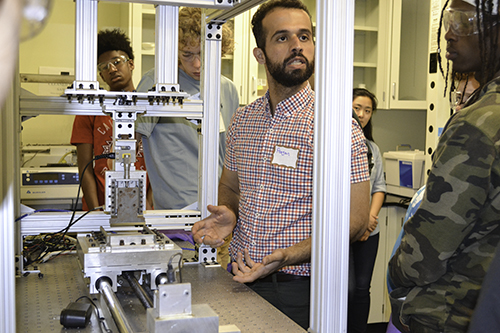
Civil Engineering PhD student Pooyan Kabir shows the high school students some of the equipment in the indentation lab.
Plus, in the afternoon, students toured a couple of Newmark’s Labs. In the indentation lab, they saw how the stones like the ones they had polished are used in indentation testing. They got to see a small drill in action: first it was pressed into a specimen, then a computer program that determines a specimen’s strength measured the microscopic indentation it had made. They also experienced Newmark Lab’s huge Crane Bay.
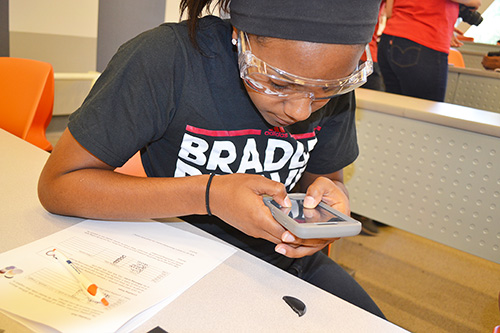 A UHS student uses her cell phone to get an upclose look at the specimen she's been polishing.
A UHS student uses her cell phone to get an upclose look at the specimen she's been polishing.According to Akono, events like this help high school students “get excited about science. They get to discover an aspect of science they wouldn't have thought about. In this case, we're looking at civil engineering. They get to understand what it is to be a civil engineer, what kind of questions we're asking, and how this is both exciting but also applicable in real life.”

A UHS student performing an indentation test in a piece of composite.
Akono also wants students to understand how her field is related to their everyday lives. She says students experience civil engineering every day, “but maybe they’ve never thought about all the people actually designing it.”
Her long-term goal is that some of the high schoolers might decide to become civil engineers themselves, and hopes “to inspire them so that later, they would select these careers and be the future engineers that we need for this country.”
While holding an event for high schoolers is extra work for Akono and her team, she believes they also benefit from the students' enthusiasm and different perspectives. “I like the breadth of the questions that they have, the diversity of questions that they have, and a lot of times, actually, I'm taken aback by an aspect that I actually hadn't thought about, so it's actually very exciting,” she admits. “I'm actually looking forward, because later, in the afternoon, they are going to go into the lab, and I want to see what types of questions they will ask.”
One of the challenges Akono encountered was to communicate her research in a way that high school students could understand. She says it’s very different teaching this age group compared to the college students she’s used to teaching.
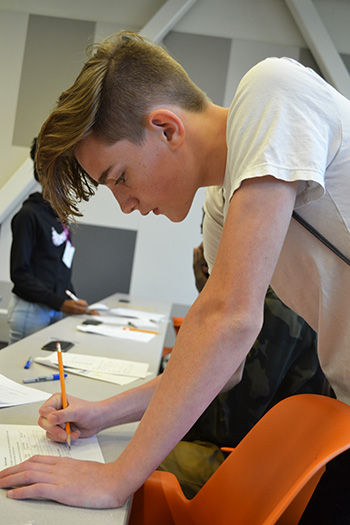
UHS student does calculations during a hands-on activity.
“I think, to some extent, it is a little harder,” she admits. “It is easier because I have to be rigorous, but I just need to make the material more accessible. But this becomes more of a challenge because there are a lot of notions for me that are very obvious. I tend to be even oblivious to those terms that have a very obvious definition. For me, it's just common sense, but I need to find a way to explain it.”
Another challenge is not just communicating to a different age level, but taking into consideration the students' interests and passions. “How do I make it relevant to their day-to-day lives?" she asks. "How do I make civil engineering relevant to a 15-year-old? How do I connect it to an iPhone? There's definitely a lot of overlap, but just having to constantly be thinking about it, that is actually why there is that level of challenge.”
In fact, at one point, to connect with the students, she did pull out a cell phone to use as an illustration when discussing materials.
She admits that, for her, a lot of challenge lies in trying to find the correct balance in terms of how challenging to make the material.
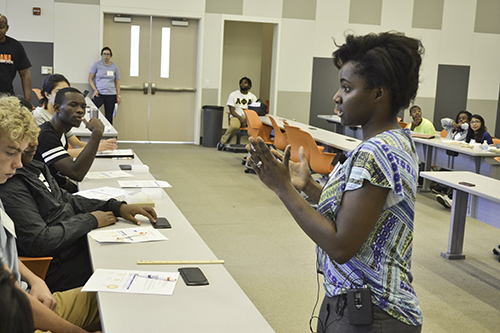
Akono explains a principle of civil engineering to the UHS students.
“I want the activity to be interesting for them and challenging, but not too challenging. College students, I'm teaching them every day. But it's been a long time since I graduated from high school and I didn't actually do my high school here in the US. So I have to kind of ask myself, is this the correct level? Is it not too hard, not too easy? Also because we don't want them to think that we're treating them as if they are kindergartners.’
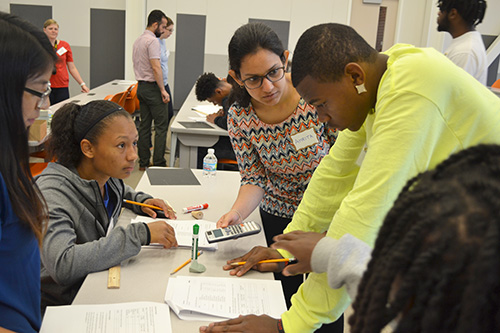
Kataruka assists UHS students in their lab work.
Amrita Kataruka, a PhD student in Akono’s lab in her second year, says she participated in the camp “mostly because I kind of like to interact with kids. So when Professor Akono told me there's going to be an outreach, I was actually excited about the idea. So I told her, ‘Sure, why not?’”
Regarding the benefit for high school students of an activity like this, Kataruka says that, “As a high schooler, they have a lot of questions in their minds about what future aspects they have or what should they choose later on. If they start doing such kind of activities, they kind of get a feel of what they're enjoying more or if this is something they want to do or not. So it basically, I think it helps them decide what they want to do later in their lives.”
Another PhD students in Akono’s lab, Pooyan Kabir agrees with Kataruka regarding the importance of bringing high school kids to events on campus in order to help them in their decision making regarding their career. “I remember when I was in high school, I didn't know what I wanted to do!” he recalls. So his dad, a mechanical engineer, and his brother, who was studying electrical engineering, took him to the university. “They showed me what each group goes through, and then I saw what they're working on and then so I had an idea.” And based on that input, “I decided to do civil engineering,” he adds. “So it's always good to bring in some new fresh high school people and then they know what they want to do in the future and that way they have an idea of what they're getting into in the future.”
Kabir, who did his undergrad in Iran, got his Master's at Texas, and is now going for his PhD at the University of Illinois. When he was in high school, did he ever think he would end up in one of the best civil engineering schools in the world? “Probably not,” he says. “My dad wouldn't have thought that either. It's a pleasure to be here. I love doing this, and I'll keep doing this as long as I'm in this environment.”
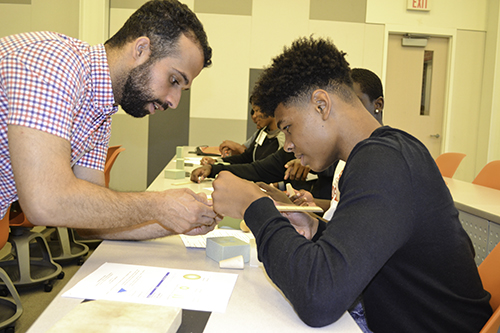
Pooyan Kabir interacts with a UHS student during one of the CEE Day hands-on activities.
Kabir says he loves working with high school kids and doing outreach, and that’s why participated in the outreach: “I had a company back home when I was young, when I was like 20 years old, and I always worked with younger people and the younger generation. I always like to inspire them and teach them something and also have fun with them. It's important to have fun as well when you're teaching them. That's what inspires me.”
Author/Photographer: Elizabeth Innes, Communications Specialist, I-STEM Education Initiative
More: 8-12 Outreach, Civil Engineering, I-STEM Initiatives, STEM Pipeline, Summer Camp, Underserved Students/Minorities in STEM, Urbana High School, 2017
For additional articles about I-STEM's 2017 Summer Camp and Professor Akono, see:
- I-STEM Multidisciplinary Summer Program Exposes UHS Athletes to Different STEM Departments/Units
- MCBees Use “Whodunit?” to Pique UHS Students’ Interest in Science During I-STEM Summer Camp
- MNTL Day Exposes UHS Students to Nanotechnology Research During I-STEM’s Summer Multidisciplinary Camp
- ECE Day at I-STEM’s Multidisciplinary Summer Camp: Soldering, Circuits, and Software
- Math Day at I-STEM’s Multidisciplinary Summer Camp Adds Up to Fun
- During I-STEM Summer Camp, Urbana High School Students’ Understanding of Aerospace Engineering Soars
- UHS Students Explore Computer Science, Coding, During I-STEM Camp’s CS Day
- At I-STEM's Multidisciplinary Summer Camp, UHS Students Have Fun with Chemistry—Everything From Soap Making To Glow Sticks to Ice Cream
- UHS Students Gear Up for Mechanical Science and Engineering During I-STEM Summer Camp
- During I-STEM Camp’s NCSA Day, UHS Students Experience Data Visualization, Super Computers, and NCSA’s Research
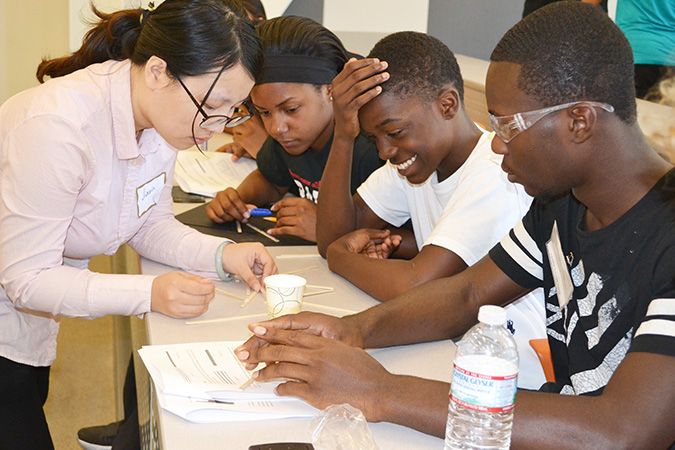
A grad student assists UHS students with their experiments.













.jpg)
















